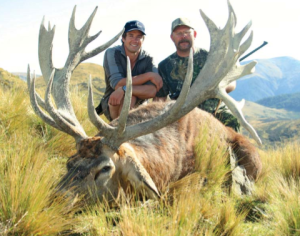Stag Party Invitation
TRACING NEW ZEALAND’S THRIVING HUNTING INDUSTRY | FIRST OF FOUR PARTS
By Simon Guild
The snow tussocks begin to wave in a different direction, indicating a shift in the cool wind. Your scent is now heading right for the quarry, and you know it’s only a matter of time before he’s onto you. Your pulse quickens, despite your best efforts to remain calm.
You’ve been here before, not this location, but in this situation. It is familiar, yet somehow different – exotic even. You remind yourself that this very moment is why you’re here: 7,000 miles from home.

You steady your rest in anticipation of what you know is coming. Sure enough, the stag lifts his head and turns to face you – its awesome rack on full display – trying to work
out what it is awakening his nostrils. You allow yourself a moment to appreciate his magnificence before focusing in on your scope; you have mere seconds before he’s gone. You steady the crosshairs and squeeze the trigger like you have so many times before.
HUNTING THE OTHER SIDE OF THE WORLD
Does this sound like something that lights your fire? You’re not alone. Every year, hunters from around the world make the pilgrimage to New Zealand to hunt the mighty red stag and a raft of other species that make up the most famous big-game hunting destination in the South Pacific. The dream New Zealand hunt is what they’re after, and making it happen shouldn’t be hard. However, like any high-involvement experience, there are a few simple yet vital actions that can ensure the dream becomes a re
ality and not a nightmare. Add this to the fact that hunting in New Zealand is largely unregulated and you’ll soon start to realize that a little research goes a long way.
My name is Simon Guild and my family has been hosting

international hunters on our estate, High Peak, for almost 30 years. We have seen a large amount of clients over the years, sharing their experiences as they undertake a journey of anticipation, excitement and ultimately success. Unfortunately, we’ve also heard our share of horror stories.
Over the next four issues of California Sportsman, I will be sharing our knowledge of the industry with you, along with a few insights that we’ve distilled into some vital actions to ensure you make the right decisions when booking your New Zealand hunt.
In this issue, we’ll set the scene by exploring the history of hunting in New Zealand, along with a bit about location and species, in terms that are relevant to you, the international-traveling hunter. In the next issue, we’ll look at the right type of New Zealand hunt for you, followed by the seven costly mistakes to avoid making. In the fourth and final installment, we’ll give you 10 frequently asked questions you should bring up to your outfitter.
Armed with this knowledge, I guarantee that you’ll be able to go forth and make your inquiries with confidence.
A HISTORY LESSON
Understanding where the New Zealand hunting industry came from provides a sound background to the advice that will follow. Wind the clock back 150 years and you’ll see a New Zealand with no species of big game – at least not as we know them.
New Zealand was a country entirely dominated by birds. The early European settlers, who were missing their favorite pastimes from back home, set about introducing myriad game species – from rabbits through to moose. Some introductions were successful, some less so, but all species were introduced on the basis of being available for every New Zealander to hunt.

Gone was the elitism and privilege of European hunting, and to this day it remains the right of every Kiwi to grab his or her rifle and head into some of the 4 million acres of public land to hunt.
Despite this egalitarian approach, some species did a little too well. In the case of red deer, the world-leading quality of the wild trophies in the 1930s and ’40s soon gave way to overpopulation and resulting habitat destruction. In response, the New Zealand government implemented deer-culling programs in the 1950s and ’60s, whereupon paid hunters armed with military surplus .303 rifles would head into the bush for weeks on end with the sole purpose of reducing deer numbers.
A few enterprising hunters began to realize there was a demand for the venison harvested as a result, and an export trade was quickly developed. While deer were recovered from remote locations by horseback, jet boat and bush plane in the beginning, it was the introduction of helicopters that really made an impact on the numbers. Initially using the machines as a means of transporting the meat out of the wilderness, the helicopter crews rapidly evolved into highly efficient aerial gun platforms, so good at what they did that they soon realized they were going to shoot themselves out of a job!
Again the pioneers adapted to the situation and turned their flying gunships into flying live-recovery platforms. The express purpose of this was to capture live deer and sling them back to newly established deer farms.
New Zealand deer farming was thus born and gave rise to a new industry in conjunction with the venison: deer velvet. The highly valued antler could fetch some serious money in the developing Asian markets, and New Zealand deer farmers quickly worked out
how to breed bigger and better antlers to capitalize on this growth.
Now, you can probably see where this is going. As a direct result of the breeding of better velvet stags, farmers also began to breed significantly wider, heavier and more multi-pointed trophy heads.
Before long, New Zealand was producing red deer trophies far in excess of any other country, and international hunters were starting to take note. Thus, the modern New Zealand trophy hunting industry was born, with red stag as its cornerstone prize among big game, closely supported by Himalayan tahr, alpine chamois, elk, fallow deer, wild boar and a handful of other species.
A GREAT HUNTING OPPORTUNITY

So what does this mean to you, the international traveling trophy hunter? Well, you now know that hunting in New Zealand is relatively free of restrictions in terms of seasons and access. You know how our big game species came to be here and how New Zealand came to lead the world in red deer and wapiti (elk) trophy genetics. And you know that the New Zealand hunting industry is an unregulated environment, one where keeping your wits about you in the initial planning stages can result in a life-changing experience for the better.
In the next issue, we’ll explore the different hunting environments in New Zealand, how they may relate to your ethics and preferences as a hunter, and a few important things that you really should be aware of. CS
Editor’s note: Simon Guild is a director of High Peak, one of the oldest hunting estates in New Zealand. He and his brother Hamish co-wrote The Hunters’ Guidebook to New Zealand with the aim of providing quality decision-making guidelines to visiting international hunters. Find out more at huntingredstag.com.



